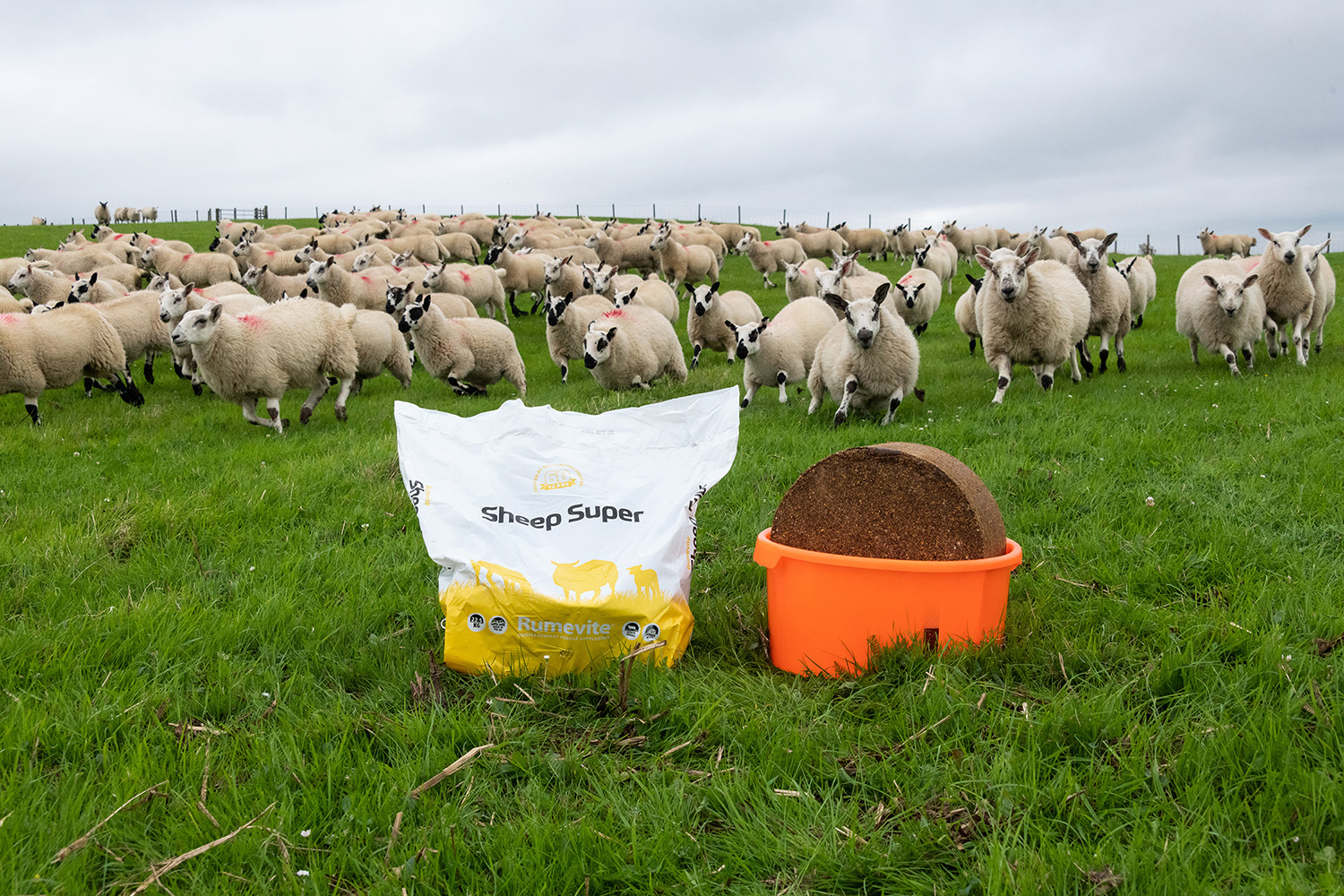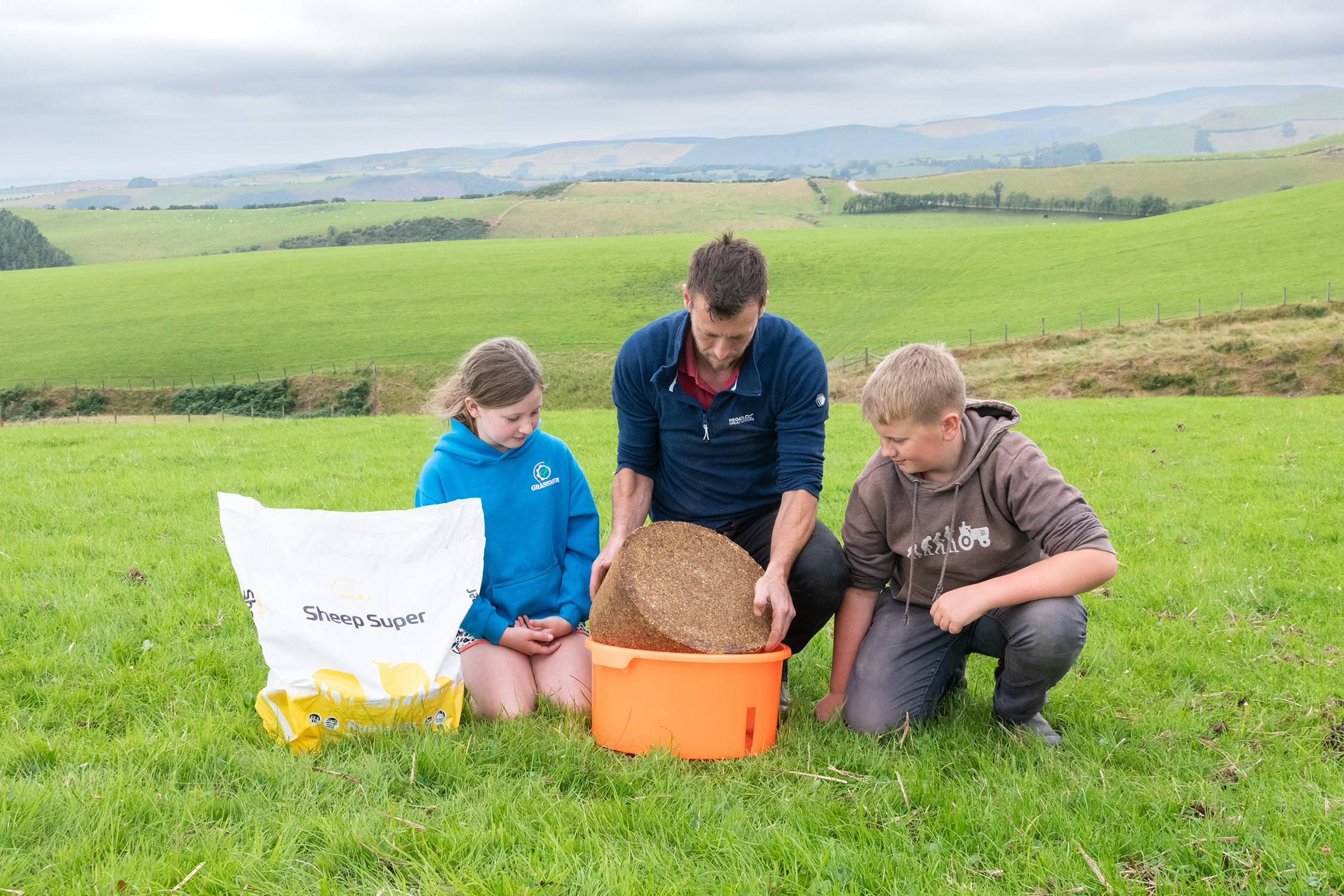Welsh farmer boosts flock performance and cuts labour by 25% with feed blocks
WELSH FARMER BOOSTS FLOCK PERFORMANCE AND CUTS LABOUR BY 25% WITH FEED BLOCKS
Keeping things simple is one of the foundations to success for Welsh hill farmers John and Alun Hopkins of Cennant Farm near Aberystwyth – helping the business cut feeding labour requirements by 25 percent, maintain a 160 percent scanning rate on hill ewes and reduce lambing assists to three percent.
With no regular labour outside of the father and son partnership and a majority of the 600-acre farm consisting of an elevation range between 600 to 1,100 feet, this basic principle has allowed the business to run a commercial flock of 1,200 breeding ewes and a 35-head herd of crossbred suckler cows.
“My son, Tomos, is 12 and has started to get involved. My daughter, Gwen, is 10 and she also helps out. Aside from a few friends and family who help with shearing and some help from my mum, Margaret, the majority of everything is done by myself and my dad – tractor work, silage, ploughing, lambing, feeding – everything,” says John. “We have to maintain a no-fuss system that allows us to maximise returns without a huge amount of labour resource.”
Opting for an outdoor lambing system, the farm’s commercial flock genetics are predominantly a 50/50 cross between Tregaron Welsh and Beulah Speckled Face. As part of the low time input system, the farm keeps 350 home-bred ewe lambs for replacements each year, selling ewes once they reach four to five years of age to lowland farms through Devils Bridge and Aberystwyth markets.
“Our land isn’t good enough to support older ewes and we’ve found a good market with consistent buyers if we sell ewes while their teeth are still decent and before they get too old,” says John. “This has helped cut down on issues like twin lambing disease and has helped maintain good flock performance while carving out a good market for these ewes.”
Focus on nutrition
With a start to lambing date of March 20, ewes are tupped to Innovis Aberdale and Aberfield rams in late October/early November.
“In early September, we start feeding rams Lifeline Ram, which is a high protein and energy bucket with fish oil and selenium for sperm quality,” says John. “It’s easy to forget about the rams and for them to get neglected so this is ideal to make sure they are getting extra nutrition without having to be fed concentrates every day.”
Thanks to their genetics, ewes can rely on forage to build body condition in the run-up to tupping with older ewes scanning 160 percent and younger ewes scanning 140 percent. Ewes don’t receive any additional feed inputs until the end of December when John starts supplementing with Rumevite Sheep Super Energy Plus Fish Oil feed blocks.
“For the last 40 years, we use 20 tonnes of Rumevite every year,” explains John. A hard pressed feed block for controlled intakes, Rumevite is a feed and mineral block that improves forage intakes and utilisation. Rumevite Sheep Super Energy Plus Fish Oil contains omega-3 fatty acids from fish oil to support pregnancy rates. It also contains high quality protein for ewe milk production.
“Rumevite replaces the need to feed hay or silage daily unless weather conditions are bad. Instead of feeding every day, I’m able to put out large Hesston bales once a week and also drop off the feed blocks at specific points spread out across the grazing area,” says John.
Reducing labour and lambing time issues
From a labour perspective, this is a huge time saver with John estimating it reduces labour requirements by a minimum of 10 hours per week. When valuing bought-in labour at £11 per hour on a 40-hour work week, this cuts the farm’s labour down by 25 percent.
“It also is more economical to feed this way. We don’t have a lot of silage or hay fields and we have to buy a large quantity of forage in from England – and that’s not cheap,” he says. “And not only is it a lot easier to feed, but blocks are also consistent in quality where hay /silage varies significantly.”
This method of feeding is also more suitable for the farm’s outdoor lambing system by not causing daily disruptions to the flock.
“The biggest disadvantage we have with concentrate feeding is mismothering issues from sheep rushing for feed. We also find that if the weather is bad, ewes that should be remaining in shelters will come out to get feed which can cause problems,” explains John. “The only sheep we feed concentrates to are twin ewes four weeks before lambing and a few weeks ager. I keep using Rumevite on these twin ewes because it helps prevent the issues caused by rushing.”
In their last five weeks of pregnancy, ewes are also provided with Lifeline Ewe and Lamb alongside Rumevite to increase colostrum quality and lamb vigor.
Lamb performance
Once spring grass growth takes off at the end of April, John pulls Rumevite from the ewes and lets them get back to being self-sufficient on forage.
Weaning in early to mid-August, lambs are finished on grass and later moved to 15 acres of brassicas that are part of the farm’s reseeding plan.
Lambs are sold deadweight to the abattoir in Dunbia, Llanybydder at an average of 17.5kg. The farm starts taking them to market in June and carries on into January. Half of the farm’s ewe lambs will be kept back for replacements and in mid-September, 300 ewe lambs will be sold directly to returning buyers for breeding at an average of 40kgs.
Continuing to progress
With interest in the farm shown by the next generation, John and Alun are both keen to keep the farm progressing forward. This includes phasing the Speckled Face genetics out for Welsh Mountain Sheep for a greater genetic diversity, increasing the use of recorded rams and do more performance recording for flock development.
“One thing that isn’t going to be changing is our use of Rumenco products,” concludes John. “These have been essential to our ability to better utilise our homegrown forage, and operate a system that isn’t reliant on heavy labour inputs and allows us to manage our flock efficiently.”

